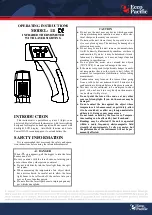
17
16
Infrared Forehead Thermometer THD2FE / 15.2024.02
Infrared Forehead Thermometer THD2FE / 15.2024.02
• The device is not waterproof. Protect it from moisture. Do not immerse in
water or other liquids.
• To clean and disinfect the unit, please follow the instructions in the section
“Care and Maintenance".
4. Measuring procedure
• Every object releases infrared energy. The optical detector senses the infrared
energy, converts this information into a digital reading and the surface tem-
perature is displayed.
4.1 Measurement of body temperature
• In the default setting, in forehead thermometer mode, the thermometer meas-
ures the temperature of the infrared heat given by the arterial blood supply
under the forehead area and converts this temperature into an oral equivalent
temperature. The measurement result is displayed within 1 second. The con-
tactless measuring method allows, for example, to take the temperature of
babies without disturbing them during sleep.
• Many people believe that normal body temperature is 37°C, however body
temperature, like blood pressure, varies from person to person and during
the day. It may range from 35.5°C (95.9°F) to 37.8°C (100.4°F).
• We should remember as well that oral temperature is normally lower by
0.5°C (0.9°F) from rectal temperature. The forehead temperature is convert-
ed by the infrared forehead thermometer to the commonly used oral tempera-
ture. For some people it may show some difference from their normal oral
temperature.
Therefore: Practice is important!
• We recommend that you practise using the thermometer on yourself and
your family when you’re in a healthy condition. In this way you can improve
your technique and obtain a reference value for normal body temperature of
each member of your family. This in turn will help you to feel more confident
to take the temperature when someone is ill.
• For repeated accurate measurement, be sure to
always measure the same
spot on the forehead
as in the following instructions.
• Discuss the measured values with your doctor.
• The temperature measured at the forehead area differs from the core body tem-
perature, which is obtained by taking an oral or rectal measurement with a clini-
cal thermometer.
• Check the measurement result with a conventional clinical thermometer
1. if you are using the thermometer for the first time, or you are not yet familiar
with the correct use of the device
2. if the measurement result is surprisingly low and does not match the state of
health
3. for newborns up to 6 months of age
4. for persons, especially small children, who react unusually in the presence or
absence of fever.
Caution!
Risk of injury:
• The instrument contains small parts that could be accidentally swallowed by
children. Keep this instrument and the batteries out of reach of children. Use
under parental supervision.
• Batteries contain harmful acids and may be hazardous if swallowed. If a bat-
tery is swallowed, this can lead to serious internal burns and death within two
hours. If you suspect a battery could have been swallowed or otherwise
caught in the body, seek medical help immediately.
• Batteries must not be thrown into a fire, short-circuited, taken apart or
recharged. Risk of explosion!
• Low batteries should be changed as soon as possible to prevent damage
caused by leaking. Never use a combination of old and new batteries together,
nor batteries of different types.
• Wear chemical-resistant protective gloves and safety glasses when handling
leaking batteries.
Important information on product safety!
• Do not place the device near extreme temperatures, vibrations or shocks.
• Protect the device from large or abrupt ambient temperature changes.
• Steam, dust, smoke, etc., can prevent accurate measurement by obstructing
the device’s optics.
TFA_No. 15.2024_Anleitung 04.05.2020 13:32 Uhr Seite 9
































